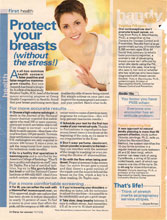Protect Your Breasts (Without the Stress!)
An all-too-common health concern: false-positive and false-negative mammogram results. But new research has found a fix. In a first-of-its-kind study, Stephen Taplin, M.D., head of the breast cancer screening program at Group Health Cooperative in Seattle, found that poor breast positioning more than doubles the odds of cancer being missed.
Simple actions on your part can improve the mammogram’s accuracy—and your comfort. Here’s what to do.
For more accurate results…
- Choose a high-volume radiologist. A study in the Journal of the National Cancer Institute reported that radiologists who read 300 or more mammograms per month are better able to tell if an image is normal—and more likely to catch cancers—than are those who read less than 100 per month. To retain their certification to read mammograms, U.S. radiologists are only required to review 480 breast X rays a year, so ask the receptionist how many tests the technician reads monthly.
- Go to a to a facility that specializes in mammograms and is certified by the American College of Radiology. “They’ll have quality radiologists on staff,” says Dr. Taplin. For a list of certified facilities, log on to fda.gov/cdrh/faclist.html or call the National Cancer Institute at 800-422-6237. (And if you switch centers, make sure your new center receives copies of your previous mammograms for compariso—this will help prevent inaccurate results).
- Schedule your test for the first two weeks of your menstrual cycle. Thanks to fluctuations in reproductive hormones, breast tissue is less dense at the beginning of the cycle, so it’s easier to see irregularities in the X ray.
- Don’t wear perfume, deodorant, talcum powder or jewelry to the test—they can interfere with the accuracy of the image by masking (or even creating the illusion of) abnormalities.
- Go with the flow when being positioned. Proper placement helps ensure the entire breast gets X rayed and that there’s a good outline of the nipple and the muscle behind the breast on the film, which is key to a clear reading, Dr. Taplin says.
For a more comfortable screening…
- For $5, you can soften the ouch with a MammoPad (mammopad.com), an FDA-approved, single-use cushion that has been shown to reduce discomfort in nearly 75 percent of cases. To find a center in your area that offers the pads, call the company at 866-460-4141.
- If you’re lowering your shoulders or standing on tiptoe, ask the technician to adjust the machine—it is possible to be comfortable and get a good image.
- Take slow, deep breaths between X rays to reduce stress. And remember, it’ll all be over in 10 short minutes!
